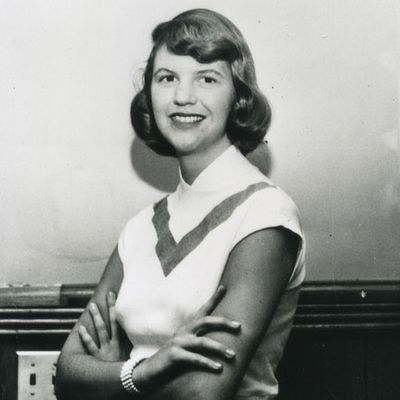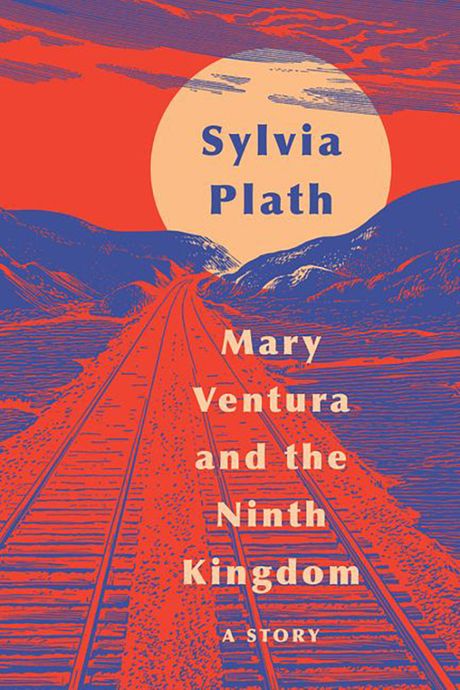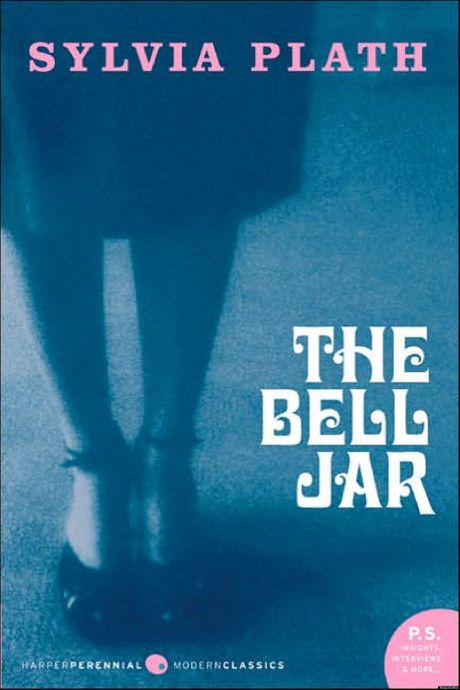
Few American authors are better known and documented, and yet as little understood, as Sylvia Plath, whose writing has long outlived her suicide of 56 years ago. The perception of a writer overshadowed by her own dark legend — that vision of the abandoned woman in despair — may help explain the strange path to publication of a “rediscovered” story that had actually been hiding in plain sight for at least four decades. And the story itself points the way toward understanding who Plath really was — and might have been.
This week, HarperCollins released Mary Ventura and the Ninth Kingdom, a stand-alone short story originally written when Plath was 20. An allegory about life, death, and independence, it follows a young woman forced to ride a train to an unknown destination — until she recognizes her own agency and makes a break for it. Aside from three children’s books released in Britain, Mary Ventura is the first newly published piece of prose by Plath since the posthumous story collection Johnny Panic and the Bible Dreams (1977). Though it’s never not a good time to publish Plath, it does seem worth asking how and why we’re seeing this story now, in 2019.
Everyone loves a treasure hunt. HarperCollins’s press release touted the story as a new find, unknown even to Plath’s estate. There was no reason to doubt that it had been freshly unearthed from some dark English cellar, because it was odd to imagine that any of her known work would not have been mined for publication. We can already read her senior thesis, her diaries, and her letters, and yet here’s a polished work we’ve never seen.
The real story is, like Plath’s own, more complicated. Originally written in 1952 for a class assignment at Smith College, “Mary Ventura” wasn’t widely known outside scholarly circles before Faber and Faber published it in the UK earlier this month. Plath had revised the piece despite discouraging comments from her professor, then sent it to her mother to retype and submit to Mademoiselle magazine — which rejected it promptly. Eventually, it went into her archives — not as lost riches but as an open secret, complete with a treasure map in the form of a finding aid.
Early this month, the question of the story’s lostness became the subject of a Twitter flare-up — the kind that quickly dies down as the messy truth emerges. On The New Yorker’s website, Katy Waldman wrote a thoughtful critique of the “lost” story: “Not even the author’s estate had known the story existed until the critic and academic Judith Glazer-Raymo stumbled over it while doing research in Plath’s archives.”
Cue Rebecca Baumann, a librarian at Indiana University’s Lilly Library, which houses Plath’s papers and ephemera. “This story wasn’t ‘lost,’” Baumann tweeted on January 7. “It is at @IULillyLibrary, where it is described in a detailed finding aid. It wasn’t ‘stumbled upon.’ … Literally thousands of researchers have accessed this material, in our collections since the late 70s.” She redefined “discovered” as “the estate lifting their restrictions and allowing this to be published at a culturally opportunistic moment.”
But according to Raymo, the timing really is incidental. A 1953 graduate of Smith, Raymo was a classmate of Plath’s (though not a friend), and had even been a finalist for the Mademoiselle guest editor position for which Plath was selected. Raymo went on to pursue a career in higher education. Decades later, in the 1980s, she began to collect Plath’s work while traveling in England.
“[Pieces] were available and not expensive then,” Raymo recalled to me over the phone. “Before I knew it, I had a collection.” But she only came onto the scene after the 1982 Sotheby’s sale of Plath’s work and papers by her mother, Aurelia Plath, which included the final manuscript of “Mary Ventura and the Ninth Kingdom.” The story reappeared for sale at Sotheby’s in 2014, but failed to sell. Two years and another failed auction later, Raymo arranged to buy the manuscript directly. Soon she realized that she had indeed purchased the revised and final version of an incredible short story. (She says she did spend time in the Lilly Library archives, but didn’t come across the story there.)
Raymo approached UK publisher Faber and Faber with scans of the piece. She also included it, along with Mademoiselle’s rejection letter, in the Grolier Club’s 2017 exhibition, “This Is the Light of the Mind: Selections from the Sylvia Plath Collection of Judith G. Raymo.” As a New Yorker and Plath devotee, I had never heard about this exhibit — which shows how easy it is for privately held work to pass through the world unnoticed, even by a writer’s biggest fans.
The real question is not whether the story was truly “lost,” but when the estate learned of the existence of a story scholars and collectors had long possessed, and why they didn’t consider publishing it earlier. Having read Janet Malcolm’s scathing 1995 book, The Silent Woman, an intensely personal examination of Plath’s posthumous gatekeepers, I’m aware of the canniness of the estate. (They did not respond to my requests for comment.) If the estate had wanted to cash in on Plath’s unpublished work, including “Mary Ventura,” they already would have done so.
Plath’s mother, Aurelia, and her literary executor and estranged widower, the famous poet Ted Hughes, used publication not as a cash cow but as a means to honor Plath’s legacy — and also to promote their own reliquary images of the Sylvia they had known. After Hughes pushed to publish The Bell Jar under Plath’s true name in 1971 in the U.S. (it had been published in the UK under the name Victoria Lucas one month before Plath’s suicide), Aurelia fought to counter the image of Plath put forth by her sole novel — that of a depressive heroine struggling to get out from under her mother’s thumb. Published in 1975, Letters Home, a selection of letters between mother and daughter, was meant to depict what Aurelia felt was Sylvia’s true nature. The effort backfired: Instead of redeeming the sweetness of their relationship, the letters were regarded as the pantomime of a placating daughter forced into the role of dutiful sycophant. Critics said that Plath would have been horrified by such a curated glimpse into her life. Hughes, in turn, edited and wrote introductions to Johnny Panic and the Bible of Dreams and Plath’s collected poems, which were awarded the Pulitzer Prize in 1982.
It almost goes without saying that Hughes was no impartial executor either. Having cheated on and left Plath shortly before the horrific London winter during which she killed herself, Hughes carried the burden of redeeming his own name as well as making hers. In addition, he bore a subtle but distinct bias toward Plath’s poetry over her prose. Britain’s poet laureate from 1984 until his death in 1998, he writes in his introduction to Johnny Panic that Plath’s “ambition to write stories was the most visible burden of her life,” implying that she struggled tirelessly with prose, whereas her poetry was the inspired stuff of legend. The great poet Hughes may have been an accurate judge of her talents, but there’s no reason his preferences should have limited the range of work made available to the public.
One thing we will never know is whether or not Plath’s ambition — had she lived — would ultimately have centered on poetry or prose. You need only consider Plath’s contemporary Adrienne Rich to see how a career could start with one focus and proceed to a rich and diverse mix of poetry and prose, the political and the personal. But Rich outlived her first marriage, and Plath did not.
Since Plath’s son Nicholas’s suicide in 2009, the estate has been managed by Frieda Hughes, the surviving child of Hughes and Plath — an artist now living in Australia, removed from the literary struggle of her extended family. Mary Ventura’s perfunctory introduction gives no rationale for the timing of its publication — though perhaps it’s well-timed to #MeToo and the subsequent focus on reasserting women’s agency. The Hudson Review will publish the story alongside a critical introduction by Plath scholar Karen V. Kukil, an associate curator of special collections at Smith and the co-editor of Plath’s collected letters (published in two volumes from 2017 to 2018).
In her New York Times review of the story, Parul Sehgal underlines the importance of recovering lost work by women writers: Through their journals and letters we see “laboratories of the self,” as well as “women becoming legible to themselves, stoking their ambition.” Sehgal calls the story “clumsy” — the overwrought apprentice work of a 20-year-old — but focuses on its broader ambitions, finding it “stirring in sneaky, unexpected ways.” Responding to HarperCollins’s focus on the story’s “female agency,” Sehgal asks, “But is agency the real point? … It is not the familiar story about a heroine and her solitary triumph but a story about aid — the aid women can provide each other; and aid that is possible only from other generations, from those who know something of the journey.”
The journey of the story to publication is as clear a testament to Plath’s ambitions and struggles as the story itself. The evidence is in Plath’s writing in the margins of the Lilly Library copy, which evinces a determination to follow her gut: where her instructor had written “too easy,” she added, “he thinks it’s too facile but use your own judgment.” In a letter to her mother on February 2, 1953, she wrote, “I know inside that [Mademoiselle] will send the story back, but I send it anyway. I deserve a couple hundred rejections, now. It’ll only make me work all the madder and harder.”
The fragile Plath of the popular imagination is deeply at odds with the writer who wore rejection as a badge of honor. And the mythology surrounding the rush of inspiration is less sexy than the reality of a driven woman who was always revising. As a teenager, I revered Plath for the anger that fueled her swift writing. As a 40-year-old, I’m heartened by the confidence that informed her determination. What’s really been “discovered” in this story’s history is the commitment and persistence of a woman struggling with mental illness and a society unwelcoming of anything that didn’t fit its definition of women’s work. To credit Ted Hughes and Aurelia Plath with bringing her work to a wide audience is a disservice to a writer who would, in time, surely have carved her own place in literary history.
Are there more pieces yet to be “discovered?” Peter K. Steinberg, who co-edited the letters with Kukil, believes that their work may well send readers and scholars back into the archives, hunting down the many pieces referred to in Plath’s letters. “Their focus may turn back to the creative works,” says Steinberg. “In the meantime, however, archives like the Lilly Library have a wealth of material waiting, impatiently I like to imagine, to be requested.”
Baumann, the Lilly librarian who had tweeted indignantly, looks forward to that. “There is a genuine opportunity here,” she says, “a moment that should be seized and run with and expanded and made into a permanent reality.” On reflection, her frustration over Plath’s “lost” story was fueled by thinking of how many other women writers don’t get even the archival attention Plath does, never mind the shot at republication. If it took 56 years to release this not-so-lost story, what about all the others, from other writers? Think of the backlists of independent and minority publishers who have disappeared over time, the zines and the oral histories. Baumann hopes only that all this publicity around one of the most famous women poets of the last century will “encourage people to start digging in libraries and archives, and even in their own attics, for women who really are lost — whose stories have not been brought to wider attention, whose obituaries remain unwritten.”



